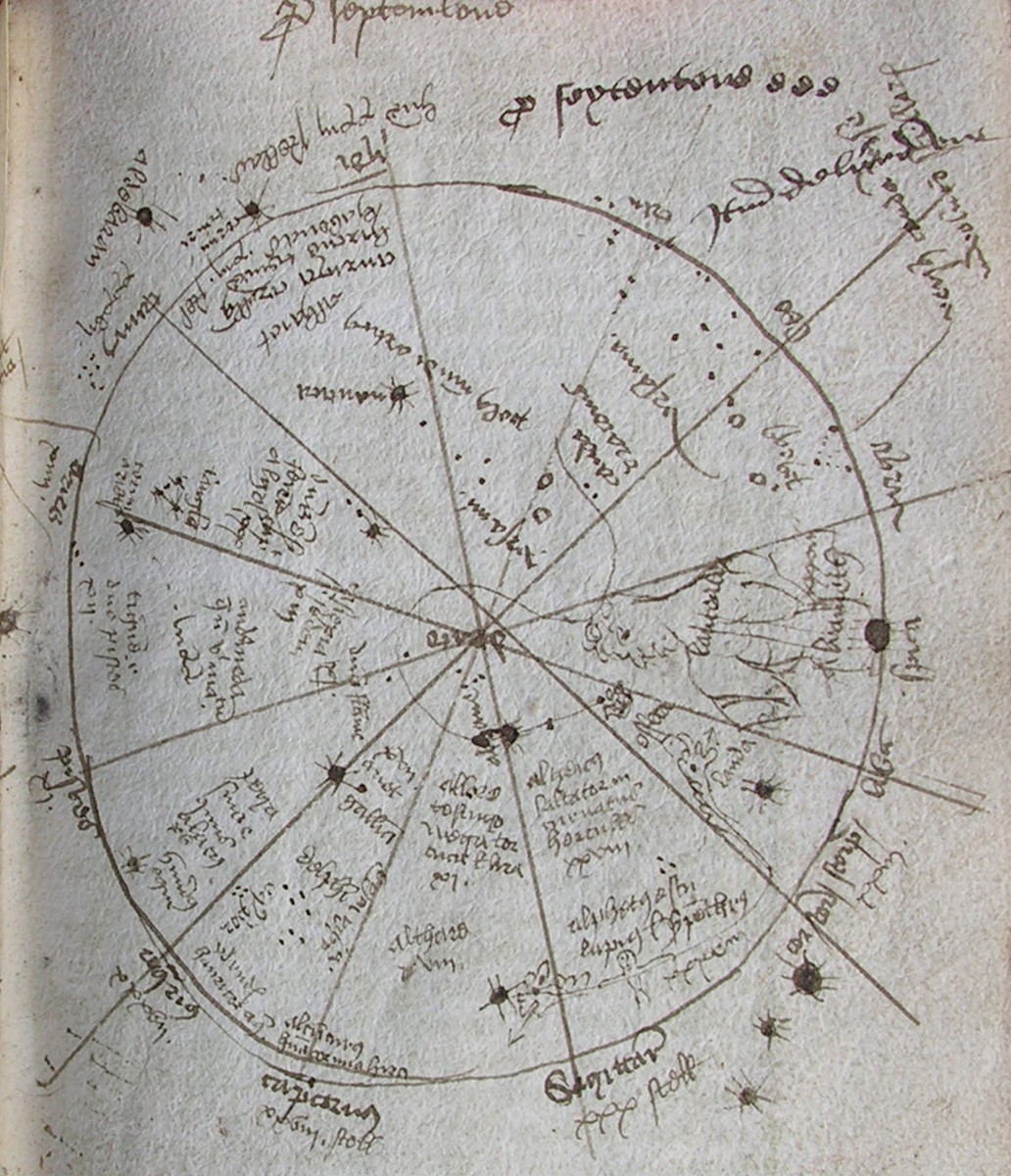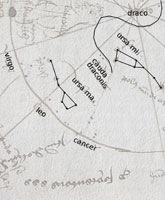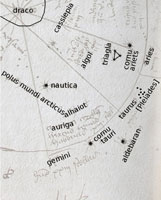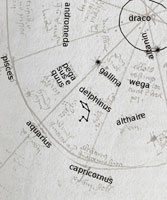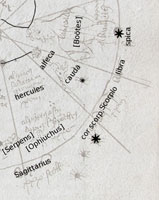|
aldebaran
Aldebaran is the brightest star in the constellation of Taurus, and one of the brightest stars in the sky. Its name is derived from Arabic, and means "the follower", as it appears to follow the Pleiades across the sky.
alfeca
The star Alphecca is the brightest star in the constellation Corona Borealis, the Northern Crown. Betson has drawn the crown on his diagram above this label.
algol
Algol is a star in the constellation Perseus. Its name is derived from the Arabic for "the head of the ogre" and it is also known as the Demon Star.
alhaiot
Alhajoth is another name for the star Capella, the brightest star in the constellation Auriga and the third brightest star in the northern sky.
altanin
Eltanin is the brightest star in the constellation Draco.
althaire
Altair is the brightest star in the constellation of Aquila, the eagle. It is one third of the Summer Triangle formed with Deneb and Vega.
andromeda
The constellation Andromeda represents a princess from the Greek legend of Perseus. Within the bounds of this constellation can be seen the Andromeda galaxy, the nearest spiral galaxy to our own Milky Way.
aquarius
The water carrier. One of the twelve constellations of the Zodiac, the path followed by the sun through the sky.
aries
The ram. One of the twelve constellations of the Zodiac, the path followed by the sun through the sky.
auriga
The constellation of Auriga takes the shape of a charioteer. Its brightest star is Capella.
[Boötes]
The large man drawn across the diagram is the constellation of Boötes, the Ploughman.
cancer
The crab. One of the twelve constellations of the Zodiac, the path followed by the sun through the sky.
capricornus
The goat. One of the twelve constellations of the Zodiac, the path followed by the sun through the sky.
cassiepia
The constellation of Cassiopeia has a distinctive 'w'-shape when seen in the night sky. It is said to represent the mythological Ethiopian Queen of the same name.
cauda
"The tail", this may refer to the constellation of Serpens, the Snake. This constellation is in two distinct parts, split in two by the constellation of Ophiuchus. Betson has here drawn a two-headed snake, and marked "cauda" (tail), where the head is today said to be.
cauda draconis
The Tail of the Dragon. The constellation Draco, the Dragon, snakes a long way across the sky, as shown by the curved line drawn all around the centre of Betson's diagram.
cor. Scorp.
The star Cor Scorpii, the Heart of the Scorpion, is also known as Antares. It is the brightest star in the constellation Scorpio.
cornu ariets
Cornu Artietis, the Horn of the Ram, is the brightest star in the small constellation Aries, the Ram. One of its traditional names is El Nath, derived from the Arabic for "the butting [horn]", and shared with Cornu Tauri.
cornu tauri
Cornu Tauri, the Horn of the Bull, is the second brightest star in the constellation Taurus, the Bull. One of its traditional names is El Nath, derived from the Arabic for "the butting [horn]", and shared with Cornu Arietis.
delphinus
The constellation of Delphinus, the Dolphin. Betson has drawn in the principal seven stars.
draco
The constellation Draco, the Dragon, snakes a long way across the sky, as shown by the curved line drawn all around the centre of Betson's diagram, ending in a curled tail.
|
gallina
Gallina is one of the traditional names of the star commonly known as Deneb, the brightest star in the constellation of Cygnus, the Swan. It is one third of the Summer Triangle formed with Altair and Vega.
gemini
The twins. One of the twelve constellations of the Zodiac, the path followed by the sun through the sky.
hercules
The constellation Hercules is named after the mythological Roman hero.
leo
The lion. One of the twelve constellations of the Zodiac, the path followed by the sun through the sky.
libra
The scales. One of the twelve constellations of the Zodiac, the path followed by the sun through the sky.
nautica
The star labelled "nautica" is in the position of the Pole Star, a star which is located almost exactly on the north celestial pole. Nautica (meaning "nautical" or "to do with ships" in Latin) is an unusual name for this star, but it may refer to its usefulness as a navigational aid for sailors.
[Ophiuchus]
The constellation of Ophiuchus is said to be a man holding the body of the Snake, and cutting that constellation into two parts. This visualization can be seen in Betson's drawing.
pegasus equus
The mythological flying horse Pegasus is represented in the skies by the constellation of the same name.
pisces
The fish. One of the twelve constellations of the Zodiac, the path followed by the sun through the sky.
[Pleiades]
The Pleiades are a cluster of seven stars very close together, also known as the Seven Sisters. Betson has marked seven dots to show the stars, but has not named them.
polus mundi arcticus
"The north pole of the world". This caption marks the place of the north star, the point around with the stars appear to rotate for observers in the northern hemisphere.
sagittarius
The archer. One of the twelve constellations of the Zodiac, the path followed by the sun through the sky.
scorpio
The scorpion. One of the twelve constellations of the Zodiac, the path followed by the sun through the sky.
[Serpens]
The constellation of Serpens, the Snake, is in two distinct parts, split in two by the constellation of Ophiuchus. Betson has drawn a two-headed snake. The head of the snake is today said to be on the right, where has Betson has, in fact, marked "tail".
spica
Spica is the brightest star in the constellation Virgo. Its name is derived from the Latin "spica virginis", meaning "Virgo's ear of grain".
taurus
The bull. One of the twelve constellations of the Zodiac, the path followed by the sun through the sky.
triagla
The constellation Triangulum is very small, and has three principal stars found in the shape of a triangle.
ursa ma.
The constellation of Ursa Major, the Great Bear. The main stars have been drawn in.
ursa mi.
The constellation of Ursa Minor, the Little Bear. The main stars have been drawn in, pointing towards the north celestial pole.
virgo
The young maid. One of the twelve constellations of the Zodiac, the path followed by the sun through the sky.
wega
Vega is the brightest star in the constellation Lyra, the Lyre, and the second brightest star in the northern sky. It is one third of the Summer Triangle formed with Altair and Deneb.
|



